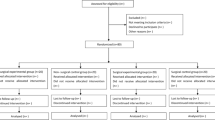Abstract
We performed a randomized, prospective, controlled, intention to treat study in order to determine the effectiveness of an antioxidant therapy in improve the quality of seminal fluid parameters and the natural pregnancies in men with persistent oligospermia (5–20 million/ml) 6 months after retrograde embolization. Forty-two subjects were enrolled and randomized in the study. Treated group (20 subjects) was assigned to receive antioxidant therapy (NAC 600 mg and vitamins–minerals). Untreated group (22 subjects) received no adjunctive medical therapy and was used as controls. Our data were analyzed with an intention to treat strategy. A statistically significant increase in sperm count after antioxidant therapy was recorded (P = 0.009). After this therapy, no statistical differences in percentage of WHO class A motile sperm (P = 0.752) and typical forms (P = 0.926) were found. The univariate logistic regression analysis showed that a man treated with antioxidant therapy presented a probability to have a normal sperm count 20-fold (OR = 20.1; CI 95% = 1.05–43.2; P = 0.014) higher than a man who was untreated. No significant impact on spontaneous pregnancies was found after antioxidant therapy. Despite this preliminary data, we show that antioxidant therapy based on a combination of NAC and micronutrient supplementation can be helpful in improve the sperm count at least in a subset of oligospermic males. However, this improving in sperm count is not associated with a significant increase in spontaneous pregnancies after 12 months.
Similar content being viewed by others
References
Aitken RJ, Baker MA, Sawyer D (2003) Oxidative stress in the male germ line and its role in the aetiology of male infertility and genetic disease. Reprod Biomed Online 7:65–70
Saleh RA et al (2002) Leukocytospermia is associated with increased reactive oxygen species production by human spermatozoa. Fertil Steril 78:1215–1224
Morley N, Curnow A, Salter L, Campbell S, Gould D (2003) N-acetyl-l-cysteine prevents DNA damage induced by UVA, UVB and visible radiation in human fibroblasts. J Photochem Photobiol B 72:55–60
Marmar JL (2001) The diagnosis and treatment of male infertility in the new millennium. Int J Fertil Womens Med 46:116–136
Marmar JL (2001) The pathophysiology of varicoceles in the light of current molecular and genetic information. Hum Reprod Update 7:461–472
Cam K et al (2004) The role of reactive oxygen species and apoptosis in the pathogenesis of varicocele in a rat model and efficacy of vitamin E treatment. Int J Androl 27:228–233
Lenzi A et al (2000) Lipoperoxidation damage of spermatozoa polyunsaturated fatty acids (PUFA): scavenger mechanisms and possible scavenger therapies. Front Biosci 5:E1–E15
Garrido N, Meseguer M, Simon C, Pellicer A, Remohi J (2004) Pro-oxidative and anti-oxidative imbalance in human semen and its relation with male fertility. Asian J Androl 6:59–65
Giannattasio A et al (2002) Glutathione peroxidase (GPX) activity in seminal plasma of healthy and infertile males. J Endocrinol Invest 25:983–986
Mancini A et al (2004) Seminal antioxidant capacity in pre- and postoperative varicocele. J Androl 25:44–49
Bhardwaj A, Verma A, Majumdar S, Khanduja KL (2000) Status of vitamin E and reduced glutathione in semen of oligozoospermic and azoospermic patients. Asian J Androl 2:225–228
Balercia G et al (2002) Coenzyme Q10 levels in idiopathic and varicocele-associated asthenozoospermia. Andrologia 34:107–111
Foresta C et al (2002) Male fertility is linked to the selenoprotein phospholipid hydroperoxide glutathione peroxidase. Biol Reprod 67:967–971
Chen SS, Chang LS, Chen HW, Wei YH (2002) Polymorphisms of glutathione S-transferase M1 and male infertility in Taiwanese patients with varicocele. Hum Reprod 17:718–725
Barbieri ER, Hidalgo ME, Venegas A, Smith R, Lissi EA (1999) Varicocele-associated decrease in antioxidant defenses. J Androl 20:713–717
Evers JL, Collins JA (2003) Assessment of efficacy of varicocele repair for male subfertility: a systematic review. Lancet 361:1849–1852
Mostafa T, Anis TH, El-Nashar A, Imam H, Othman I (2001) A. Varicocelectomy reduces reactive oxygen species levels and increases antioxidant activity of seminal plasma from infertile men with varicocele. Int J Androl 24:261–265
Ames BN (2004) A role for supplements in optimizing health: the metabolic tune-up. Arch Biochem Biophys 423:227–234
Gattuccio F, De Rose AF, Latteri MA (eds) (2000) Varicocele 2000.Cofese Editore, Palermo
Allamaneni SS, Naughton CK, Sharma RK, Thomas AJ Jr, Agarwal A (2004) Increased seminal reactive oxygen species levels in patients with varicoceles correlate with varicocele grade but not with testis size. Fertil Steril 82:1684–1686
Zini A, Buckspan M, Jamal M, Jarvi K (1999) Effect of varicocelectomy on the abnormal retention of residual cytoplasm by human spermatozoa. Hum Reprod 14:1791–1793
Mancini A, Meucci E, Milardi D et al (2004) Seminal antioxidant capacity in pre and post-operative varicocele. J Androl 25(1):44–49
Comhaire FH, Mahmoud A, Eertmans F, Schoonjans F (2005) Combined conventional/antioxidant "Astaxanthin" treatment for male infertility: a double blind, randomized trial. Asian J Androl 7(3):257–262
Azzi A, Davies KJ, Kelly F (2004) Free radical biology—terminology and critical thinking. FEBS Lett 558:3–6
Dickinson DA, Forman HJ (2002) Glutathione in defense and signaling: lessons from a small thiol. Ann N Y Acad Sci 973:488–504
Kumar TR et al (2000) Reproductive defects in gamma-glutamyl transpeptidase-deficient mice. Endocrinology 141:4270–4277
Irvine DS (1996) Glutathione as a treatment for male infertility. Rev Reprod 1:6–12
Author information
Authors and Affiliations
Corresponding author
Rights and permissions
About this article
Cite this article
Paradiso Galatioto, G., Gravina, G.L., Angelozzi, G. et al. May antioxidant therapy improve sperm parameters of men with persistent oligospermia after retrograde embolization for varicocele?. World J Urol 26, 97–102 (2008). https://doi.org/10.1007/s00345-007-0218-z
Received:
Accepted:
Published:
Issue Date:
DOI: https://doi.org/10.1007/s00345-007-0218-z




